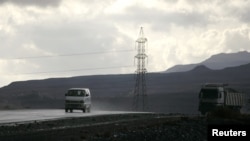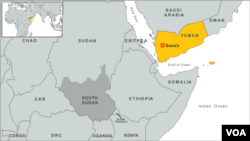SANA'A —
The Republic of Yemen - unlike its oil-rich neighbors on the Arabian Peninsula -- has been forced to explore alternative forms of energy to offset low crude oil production.
But while desperate government officials in the capital, Sana’a scramble to revive an economy shattered by last year’s anti-government uprisings, renewable energy investments remain on the back burner.
In the face of the uprisings, the Yemeni government and international actors froze millions of dollars earmarked for alternative energy projects and in many cases redirected the funds to what they considered more urgent priorities.
One such project, a 60 megawatt wind farm in Al Mokha city, had been stalled since Yemen’s political upheavals began, but is “now moving,” according to Wael Zakout, country manager of Yemen’s World Bank office.
Located along Yemen’s southern Red Sea coast, the proposed site overlooks the Bab Al Mandeb Strait, a waterway through which more than three million barrels of crude oil shipments sail daily. Currently, Yemen produces about 1,000 megawatts of electricity nationwide -- about a third of consumer demand. The shortfall is a major cause of chronic power outages that can last for hours, days or even weeks in the more remote parts of the country.
The inconsistent power supply is double edged.
“If there was no cutoff, [people] would not buy solar,” says Abdulmajeed al-Wahbani, who sells solar power equipment.
The increased sale of solar systems, however, is overshadowed by the fact that the power outages severely limit Yemen’s industrial productivity and economic growth, especially in rural areas.
Not surprisingly, as the frequency of the power outages has increased in recent years, so have efforts to address the problem.
Using renewable energy sources could help alleviate the country’s power woes, or theoretically eliminate them, according to Ministry of Electricity figures, which estimate that nearly 35,000 megawatts of wind power and over 18,000 megawatts of solar power eventually could be produced in Yemen.
Pilot projects
On the outskirts of Sana’a, the U.S. Agency for International Development (USAID) is developing an experimental greenhouse program that combines solar power with state-of-the-art agricultural techniques to help farmers achieve as much as a 10-fold increase in their crop yields.
The first model greenhouse opened in August and has proven popular, in large part because of its integrated approach. USAID partnered with a local farmers association, which trains members and connects them with equipment vendors. The goal, they say, is to see the ideas and technology gain momentum and eventually spread from farmer to farmer.
“When farmers see the benefits from other farmers, this is a message bigger than [ours],” says Mohmmed Muharram, the agriculture officer at USAID’s implementing partner, Community Livelihoods Project.
So far, more than 400 farmers have visited the site, and there were plans to build 12 more in six governorates around Yemen. Yet whether those plans will go ahead is unclear. Muharram says he has been told the program is currently funded only through June of 2013.
Similar community development models have been successful in Iraq, Jordan and Morocco.
Another promising enterprise, which also has been idle for about a year, is called The Rural Energy Access project. It was approved by the World Bank in 2009 and is designed in part to provide solar power to homes in remote areas.
“The off-grid [portion of the] program is expected to provide electricity supply to 18,000 additional rural households, including 3,000 in the fringe areas of the 12 governorates, and 15,000 in the off-grid areas,” says Zakout. “Due to the political crisis in the last couple of years, the implementation was delayed," he added, “but with the relative calm in the country in recent months, the Bank has reopened its program and implementation of this project will start soon.”
Obstacles
Despite the need and interest in such programs, little has changed on the ground.
No participant in the USAID program has purchased a solar system yet, and only four wealthy farmers have installed the latest irrigation technology. That could be because it costs the equivalent of $15,000 for the greenhouse, irrigation system and solar units. The average Yemeni farmer would need funding from either international donors or the government in Sana'a.
And according to Abdulaziz Daer, a general manager at Dome Trading, an energy sector service provider, there is another significant obstacle to renewable energy growth -- the lack of a legal framework for investment. He sees public-private partnerships as a necessary component of Yemen’s power generation plans, but says private companies are reluctant to invest on the commercial scale because there are no legal protections or purchase guarantees from the government.
“The government has to subsidize renewable energy," he concludes.
Adel Abdulghani, the general director of planning and information at the Ministry of Electricity, says that there is a tendency for the ministry to “[address] the problem when it comes." In regard to subsidies on conventional power generation, Abdulghani says that the government has plans to gradually reduce support for conventional power generation, but in the short-term, "you cannot stop subsidizing and take that money for renewable energy; that is practicably impossible."
Governmental and aid groups aside, renewable energy in Yemen faces a host of other challenges, including an unstable security situation, an inadequate power transmission system, low public awareness and the absence of financing mechanisms to help with the high start-up costs.
The U.S. ambassador in Sana’a, Gerald Feierstein, however, says Yemen could be well placed to “leapfrog over other countries” in the region when it comes to renewal energy production. Feierstein recently led a delegation of Yemeni businessmen to the United States to meet with, among others, officials of renewable energy companies. He says Yemen’s relative lack of development in the power sector may, in the long term, actually be of help to those interested in investing in renewable energy in the country.
But while desperate government officials in the capital, Sana’a scramble to revive an economy shattered by last year’s anti-government uprisings, renewable energy investments remain on the back burner.
In the face of the uprisings, the Yemeni government and international actors froze millions of dollars earmarked for alternative energy projects and in many cases redirected the funds to what they considered more urgent priorities.
One such project, a 60 megawatt wind farm in Al Mokha city, had been stalled since Yemen’s political upheavals began, but is “now moving,” according to Wael Zakout, country manager of Yemen’s World Bank office.
Located along Yemen’s southern Red Sea coast, the proposed site overlooks the Bab Al Mandeb Strait, a waterway through which more than three million barrels of crude oil shipments sail daily. Currently, Yemen produces about 1,000 megawatts of electricity nationwide -- about a third of consumer demand. The shortfall is a major cause of chronic power outages that can last for hours, days or even weeks in the more remote parts of the country.
The inconsistent power supply is double edged.
“If there was no cutoff, [people] would not buy solar,” says Abdulmajeed al-Wahbani, who sells solar power equipment.
The increased sale of solar systems, however, is overshadowed by the fact that the power outages severely limit Yemen’s industrial productivity and economic growth, especially in rural areas.
Not surprisingly, as the frequency of the power outages has increased in recent years, so have efforts to address the problem.
Using renewable energy sources could help alleviate the country’s power woes, or theoretically eliminate them, according to Ministry of Electricity figures, which estimate that nearly 35,000 megawatts of wind power and over 18,000 megawatts of solar power eventually could be produced in Yemen.
Pilot projects
On the outskirts of Sana’a, the U.S. Agency for International Development (USAID) is developing an experimental greenhouse program that combines solar power with state-of-the-art agricultural techniques to help farmers achieve as much as a 10-fold increase in their crop yields.
The first model greenhouse opened in August and has proven popular, in large part because of its integrated approach. USAID partnered with a local farmers association, which trains members and connects them with equipment vendors. The goal, they say, is to see the ideas and technology gain momentum and eventually spread from farmer to farmer.
“When farmers see the benefits from other farmers, this is a message bigger than [ours],” says Mohmmed Muharram, the agriculture officer at USAID’s implementing partner, Community Livelihoods Project.
So far, more than 400 farmers have visited the site, and there were plans to build 12 more in six governorates around Yemen. Yet whether those plans will go ahead is unclear. Muharram says he has been told the program is currently funded only through June of 2013.
Similar community development models have been successful in Iraq, Jordan and Morocco.
Another promising enterprise, which also has been idle for about a year, is called The Rural Energy Access project. It was approved by the World Bank in 2009 and is designed in part to provide solar power to homes in remote areas.
“The off-grid [portion of the] program is expected to provide electricity supply to 18,000 additional rural households, including 3,000 in the fringe areas of the 12 governorates, and 15,000 in the off-grid areas,” says Zakout. “Due to the political crisis in the last couple of years, the implementation was delayed," he added, “but with the relative calm in the country in recent months, the Bank has reopened its program and implementation of this project will start soon.”
Obstacles
Despite the need and interest in such programs, little has changed on the ground.
No participant in the USAID program has purchased a solar system yet, and only four wealthy farmers have installed the latest irrigation technology. That could be because it costs the equivalent of $15,000 for the greenhouse, irrigation system and solar units. The average Yemeni farmer would need funding from either international donors or the government in Sana'a.
And according to Abdulaziz Daer, a general manager at Dome Trading, an energy sector service provider, there is another significant obstacle to renewable energy growth -- the lack of a legal framework for investment. He sees public-private partnerships as a necessary component of Yemen’s power generation plans, but says private companies are reluctant to invest on the commercial scale because there are no legal protections or purchase guarantees from the government.
“The government has to subsidize renewable energy," he concludes.
Adel Abdulghani, the general director of planning and information at the Ministry of Electricity, says that there is a tendency for the ministry to “[address] the problem when it comes." In regard to subsidies on conventional power generation, Abdulghani says that the government has plans to gradually reduce support for conventional power generation, but in the short-term, "you cannot stop subsidizing and take that money for renewable energy; that is practicably impossible."
Governmental and aid groups aside, renewable energy in Yemen faces a host of other challenges, including an unstable security situation, an inadequate power transmission system, low public awareness and the absence of financing mechanisms to help with the high start-up costs.
The U.S. ambassador in Sana’a, Gerald Feierstein, however, says Yemen could be well placed to “leapfrog over other countries” in the region when it comes to renewal energy production. Feierstein recently led a delegation of Yemeni businessmen to the United States to meet with, among others, officials of renewable energy companies. He says Yemen’s relative lack of development in the power sector may, in the long term, actually be of help to those interested in investing in renewable energy in the country.









